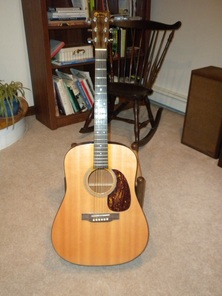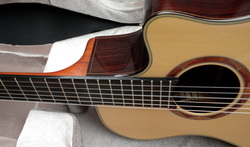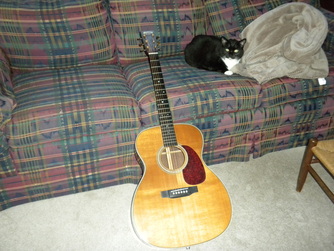I suggested that a buyer should go into a purchase of one of these instruments with his or her eyes open, that no matter how nice that guitar might be, its resale value was not likely to be any better (or worse) than a middle to top of the line guitar by one of the respected and well known large quantity builders in this country. At least for a period of some years. This, in spite of the fact that the custom, small builder guitar may be extremely limited in numbers or even a "one-of."
Well, lemme tell ya! A few of the people in that thread all but called me an ignorant fool who had no appreciation or knowledge of why someone would buy one of those guitars in the first place. "You should NEVER buy or not buy a guitar because of its potential resale value!" they shouted (electronically). "You buy a guitar because you LOVE it and it SPEAKS to you! And because you appreciate the fine workmanship and extra care that went into it!"
"Yeah, but...." said I. But righteous indignation being a powerful drug, the slams continued. And the Righteously Indignant continued to miss my point entirely.
For goodness sake, of course you buy a guitar - for big, big money in these cases - because you like it ... a lot! My reality is pretty typical I suspect and that was the point I was trying to make: no matter what, you must take into account resale value. Unless you have unlimited funds or are willing to put the ownership of a fine guitar ahead of day to day economic challenges you may face from time to time you should always keep in the back of your mind the idea that you might have to sell that guitar some day. That's all I was trying to say. I probably should have been clearer.
I subscribe to Acoustic Guitar and to Fretboard Journal magazines. In a recent edition of Acoustic Guitar I counted 43 ads for different guitar makes, some big and well known, some that may be shops that only produce a handful of guitars every year. So how do you decide which way to go? Research is the key. Hands-on research, first and foremost. Online research by scouring various internet forums (keeping in mind that you will find much contradiction and bias). Research by way of one-to-one conversations with players of varying ability levels. Input from people who repair guitars for a living. All these things help, but the first one - playing as many guitars as possible - is the most important.
Yes, you say, but wait a minute. The boutique guitar maker whose instruments I'm considering is far away, and in any case, the instrument I want will have to be built because there just isn't one from that builder with all the appointments I want.
Then, friends, what we have is a leap of faith. An educated guess. Are you will to spend three, four, five thousand dollars or more based upon a builder's past work?
Now let's consider my very first point. Suppose you say yes, and long, anxious months from now your dream guitar is delivered. It is everything you hoped it would be, maybe more! You're thrilled and you play it for hours every day.
Weeks and months pass but one day you are suddenly faced with a very large money issue. You look around and there sits that multi-thousand dollar guitar. It breaks your heart, but you know what you have to do. And there is where things get cloudy.
Even if that guitar maker is somewhat known in acoustic guitar circles, know that potential buyers are going to have to make many of the same leaps of faith you did. The cold hard reality is that those leaps are much shorter with a Martin or Taylor or Gibson. Those makers have the benefit of history, well known consistency of product - and yes, proven resale value. Can you say that about the boutique guitar? Maybe. Maybe not.
But my guitar is amazing, you say. The sound, the construction, the quality of the wood...
You know what? It had better be. Because if it is just average in any of those categories, you have a problem. The potential buyer presupposes a boutique guitar will be something that the big manufacturers cannot live up to on a consistent basis.
Ah, but the guitar world is a fickle place. Sometimes it's tough to find an explanation for why a certain guitar company is consistently a good value and another is only average. Cases in point: Olson guitars. Always bring huge dollars on the used market, when one comes up at all. Are they that much better than other boutique guitars? Does the fact that James Taylor is always seen playing an Olson have anything to do with it?
Guild guitars. Until recently, a well known and well respected American guitar maker. (Although they are now again made in the U.S., for the last decade they have bounced around and were made in China for while.) But for some reason even the older Guilds (acoustics) have never been worth much compared to the other American makers' instruments. Why? They are a little heavy and overbuilt compared to Martins and Gibsons but the fit and finish on the pre 1998 Guilds is just fine and they sound and play just fine.
I truly wish I could offer some formula or solid opinion about which way you should go if you're thinking about a new or used guitar by a large vs. a small maker but I just can't. Perhaps you'll turn out to be one of those guitarists who has a lifelong relationship with one fine guitar. If that is the case, I am deeply envious.
If you're like me (and I hope you're not - I've owned better than three dozen acoustics in my search of the "one") and have to consider a guitar something like a very, very nice liquid asset, I wish you luck and hope you're fortunate enough to find another pilgrim on the same journey when it's time to sell your guitar.
Peace & good music,
Gene



 RSS Feed
RSS Feed